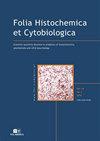新生牦牛和成年牦牛胸腺免疫组织化学分析。
IF 1.7
4区 生物学
Q4 BIOCHEMISTRY & MOLECULAR BIOLOGY
引用次数: 2
摘要
胸腺是功能性T淋巴细胞发育和成熟的部位,对免疫系统至关重要。本研究旨在检测牦牛胸腺中T淋巴细胞、巨噬细胞、树突状细胞、B淋巴细胞和浆细胞标志物的表达。材料与方法20头健康公牦牛分为新生牦牛组(2 ~ 4周龄,n = 10)和成年牦牛组(3 ~ 4岁,n = 10)。采用qRT-PCR法检测各组细胞主要标记物mRNA表达水平。免疫组化检测CD3+ T淋巴细胞、CD68+巨噬细胞、SIRPα+树突状细胞、CD79α+ B淋巴细胞、IgA和IgG+浆细胞的分布。结果在同一年龄组中,CD3ε mRNA表达量最高(P < 0.05),其次是CD68、SIRPα、CD79α、IgG和IgA。新生牦牛CD3ε、CD68和SIRPα mRNA表达量显著高于成年牦牛(P < 0.05), CD79α、IgA和IgG mRNA表达量显著高于成年牦牛(P < 0.05)。免疫组化结果显示CD3+ T淋巴细胞定位于胸腺皮层和髓质。CD68+巨噬细胞、SIRPα+树突状细胞、CD79α+ B淋巴细胞、IgA+和IgG+浆细胞主要分布在皮质-髓质区和髓质。在同一年龄组中,CD3+ T淋巴细胞频率高于CD68+巨噬细胞和SIRPα+树突状细胞(P < 0.05),其次是CD79α+ B淋巴细胞和IgA+、IgG+浆细胞。两年龄组牦牛胸腺B淋巴细胞和浆细胞频率差异无统计学意义(P < 0.05)。CD3+、CD68+和SIRPα+细胞的频率从新生儿到成人下降(P < 0.05)。而CD79α+、IgA+和IgG+细胞的出现频率在新生牦牛和成年牦牛之间呈上升趋势(P < 0.05)。结论新生牦牛胸腺发育良好,T淋巴细胞、巨噬细胞和树突状细胞数量均高于成年牦牛。然而,在成人胸腺中检测到更高频率的浆细胞和B淋巴细胞,这表明随着该器官的退化,成人可能通过体液免疫更好地抵抗感染。此外,IgA和IgG浆细胞的数量没有显著差异,这与啮齿动物和人类的观察结果不同。这种差异可能与牦牛生活在低氧高原有关。本文章由计算机程序翻译,如有差异,请以英文原文为准。
Immunohistochemical analysis of the thymus in newborn and adult yaks (Bos grunniens).
INTRODUCTION
The thymus is the site of development and maturation of functional T lymphocytes and is critically important to the immune system. The purpose of this study was to examine the expression of markers of T lymphocytes, macrophages, dendritic cells, B lymphocytes and plasmocytes in the yak thymus.
MATERIALS AND METHODS
Twenty healthy male yaks were divided into newborn (2-4 weeks old, n = 10) and adult (3-4 years old, n = 10) group. qRT-PCR was used to evaluate the mRNA expression level of the main markers of the studied cell types. Immunohistochemistry was used to detect the distribution of CD3+ T lymphocytes, CD68+ macrophages, SIRPα+ dendritic cells, CD79α+ B lymphocytes, IgA and IgG+ plasmocytes.
RESULTS
Within the same age group, the mRNA expression of CD3ε was highest (P < 0.05), followed by that of CD68, SIRPα, CD79α, IgG and IgA. Furthermore, CD3ε, CD68, and SIRPα mRNA expression levels were higher in newborn yaks than in the adult ones (P < 0.05), whereas those of CD79α, IgA, and IgG were higher in adults (P < 0.05). Immunohistochemical results showed localization of CD3+ T lymphocytes in the thymic cortex and medulla. CD68+ macrophages, SIRPα+ dendritic cells, CD79α+ B lymphocytes, IgA+ and IgG+ plasmocytes were mainly observed in the cortico-medullary region and medulla. In the same age group, the frequency of CD3+ T lymphocytes was higher than that of CD68+ macrophages and SIRPα+ dendritic cells (P < 0.05), followed by those of CD79α+ B lymphocytes and IgA+ and IgG+ plasmocytes. No significant difference was observed between B lymphocyte and plasmocyte frequencies in the yak thymus in both age groups (P > 0.05). The frequency of CD3+, CD68+ and SIRPα+ cells decreased from newborns to adults (P < 0.05). However, the frequencies of CD79α+, IgA+ and IgG+ cells increased from newborn to adult yaks (P < 0.05).
CONCLUSIONS
The thymus of newborn yaks is well-developed, with higher numbers of T lymphocytes, macrophages, and dendritic cells than those in the adult thymus. However, higher frequencies of plasmocytes and B lymphocytes were detected in the adult thymus, suggesting that adults may better resist infections through humoralimmunity as this organ undergoes involution. Furthermore, there was no significant difference in the number of IgA and IgG plasmocytes, which differs from what is observed in rodents and humans. This difference might be related to the fact that yaks live in low-oxygen plateaus.
求助全文
通过发布文献求助,成功后即可免费获取论文全文。
去求助
来源期刊

Folia histochemica et cytobiologica
生物-生化与分子生物学
CiteScore
2.80
自引率
6.70%
发文量
56
审稿时长
6-12 weeks
期刊介绍:
"Folia Histochemica et Cytobiologica" is an international, English-language journal publishing articles in the areas of histochemistry, cytochemistry and cell & tissue biology.
"Folia Histochemica et Cytobiologica" was established in 1963 under the title: ‘Folia Histochemica et Cytochemica’ by the Polish Histochemical and Cytochemical Society as a journal devoted to the rapidly developing fields of histochemistry and cytochemistry. In 1984, the profile of the journal was broadened to accommodate papers dealing with cell and tissue biology, and the title was accordingly changed to "Folia Histochemica et Cytobiologica".
"Folia Histochemica et Cytobiologica" is published quarterly, one volume a year, by the Polish Histochemical and Cytochemical Society.
 求助内容:
求助内容: 应助结果提醒方式:
应助结果提醒方式:


